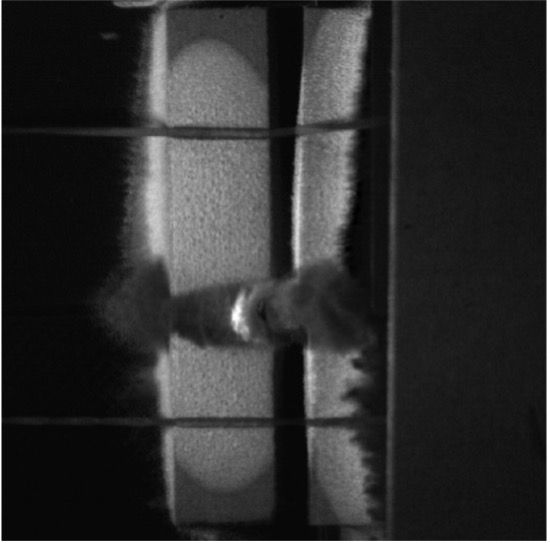Ariane group has kindly permitted Specialised Imaging to share a sequence taken of a shockwave travelling through an energetic material. The sequence was captured by the Specialised Imaging KIRANA ultra high-speed camera running at 5 million frames/second.
Capturing shock waves travelling though solids is an application often captured by the KIRANA camera. Another example can be seen via the link below, where shock transmission through concrete is visualized using Digital Image Correlation analysis of the images:
Kirana05 - Digital Image Correlation: Split Hopkinson Pressure Bar impact on concrete 2M FPS (youtube.com)
However, there are two significant differences between the two applications. One is the hazardous nature of energetic materials, and the other is that energetic material shocks are generated by a primary (donor) charge that detonates adjacent to the acceptor material. This presents two issues, firstly the whole test set up is destroyed. Secondly, the self-illuminating nature of the donor can saturate and obscure the acceptor with light.
So how can the over brightness (saturation) generated by one area of the set up be mitigated to clearly capture the area of interest which is not self-illuminating and significantly darker? There is rarely enough camera sensor dynamic range to allow one exposure time setting to reduce the saturation affect, while also allowing a bright enough image of the darker area of interest.
One step to achieving a usable exposure time is to add supplementary lighting to raise the brightness of the darker region to a level closer to the self-illuminating region. For this application the light generated by the donor charge is significant and too hazardous for expensive lasers, LED’s or flash lamps, so for these tests a sacrificial argon “flash-bomb” was used to deliver the supplementary illumination required. It was placed very close to the event and generated significant light for tens of microseconds. Whilst this illuminates the area of interest sufficiently to allow a short enough shutter to freeze motion blur – it does not “balance” the lighting enough to stop the over saturation of light from the donor charge.
For the sequence below the answer was very simple and made possible by the microsecond timescale of shock transmission: A piece of cardboard was placed between the donor charge and camera field of view to obscure the flash and hold back the products of the detonating donor charge for long enough to see the shock transition. Since everything in the test area is destroyed, using cheap and easily available materials is paramount - and sometimes the solution can also be very simple.
KIRANA Detonic shock 5Mfps Ariane (youtube.com)




























